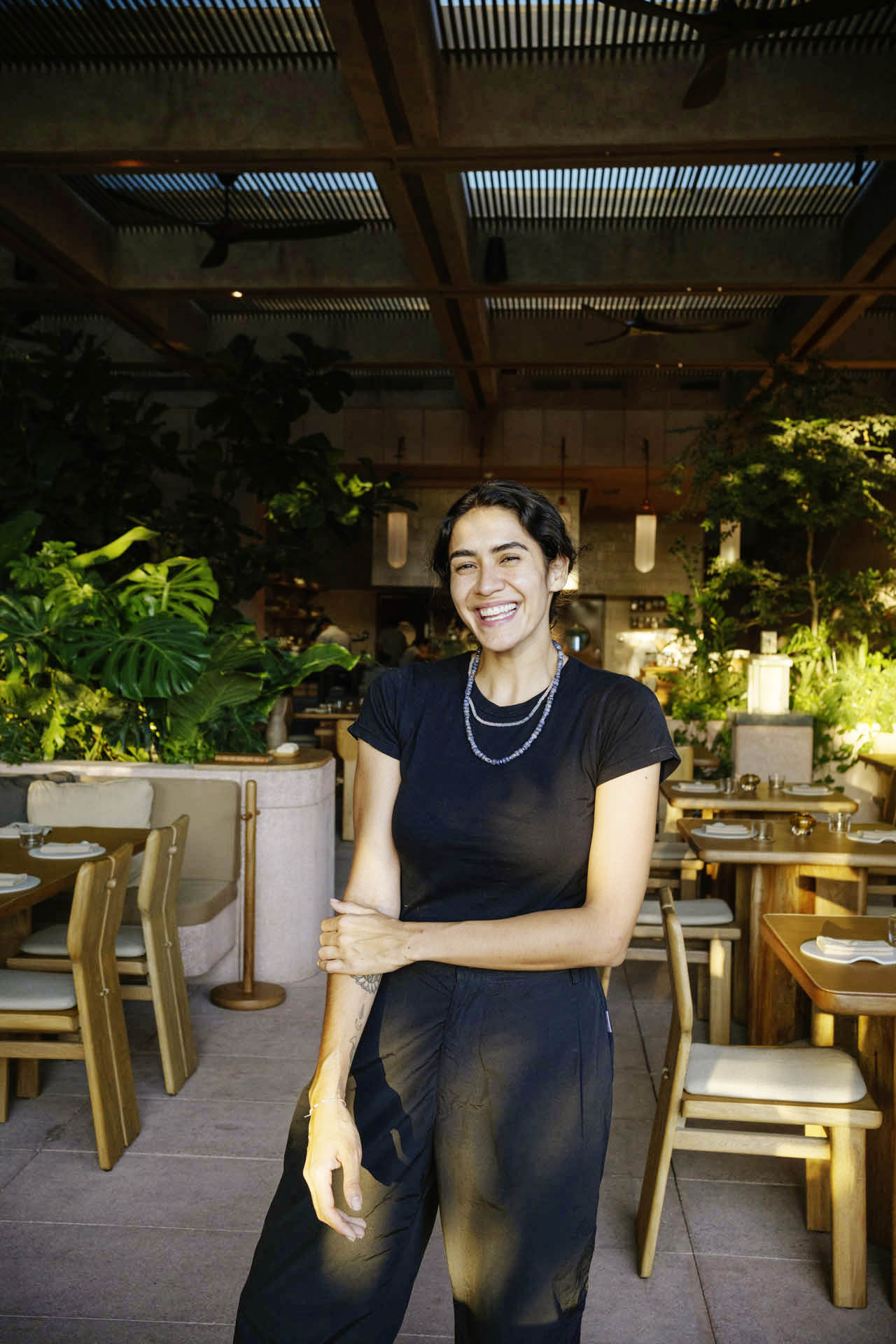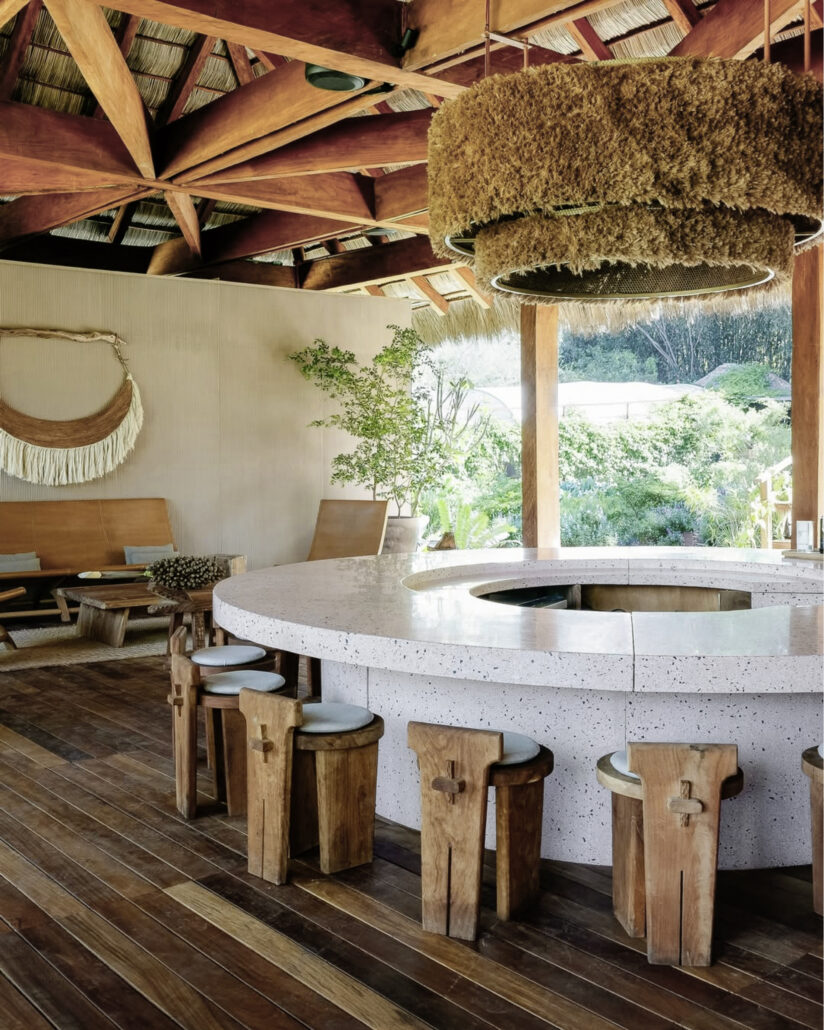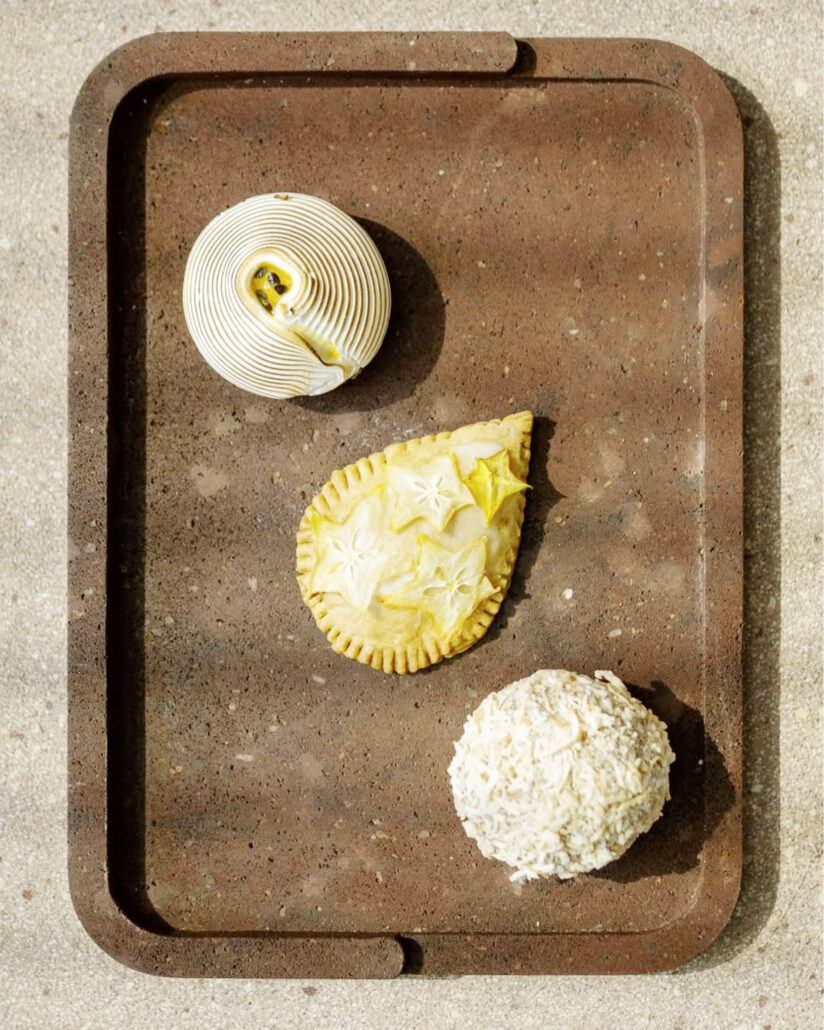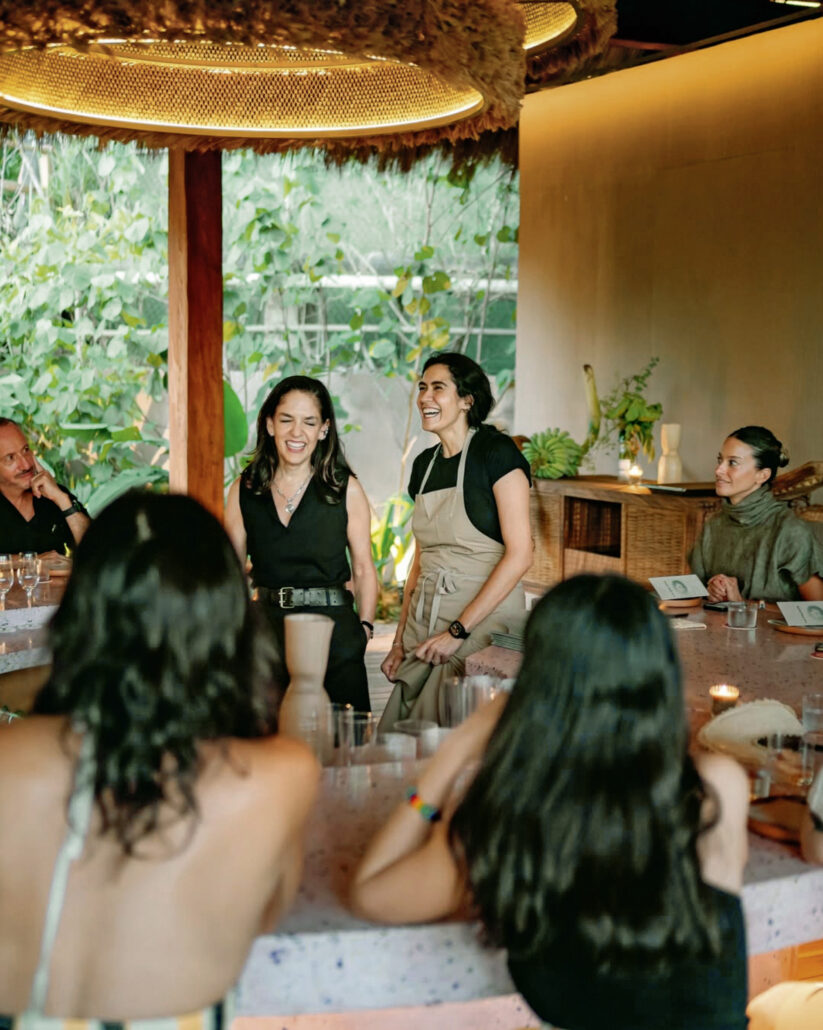Longview
A Brand Called You!
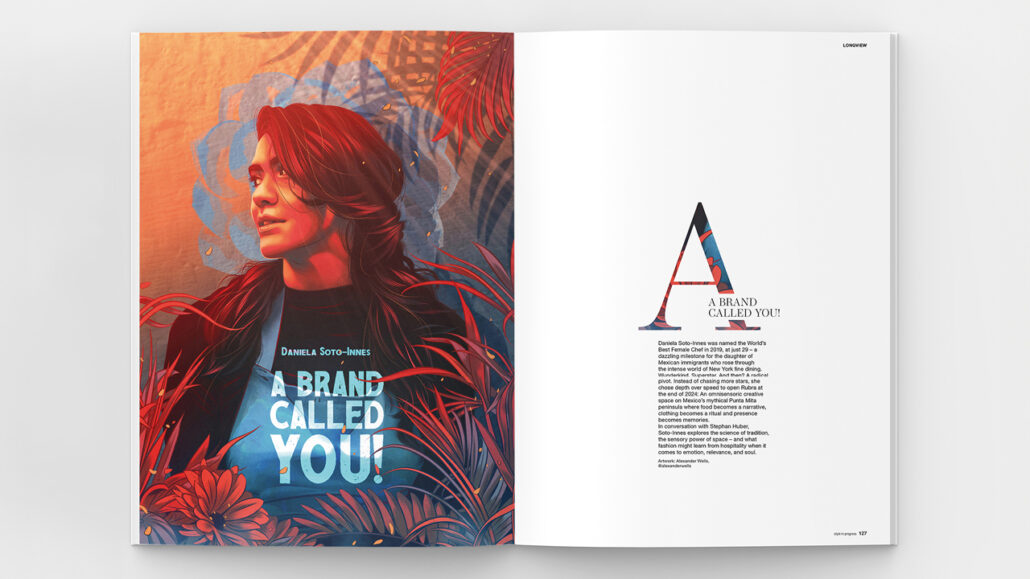
Daniela Soto-Innes was named the World’s Best Female Chef in 2019, at just 29 – a dazzling milestone for the daughter of Mexican immigrants who rose through the intense world of New York fine dining. Wunderkind. Superstar. And then? A radical pivot. Instead of chasing more stars, she chose depth over speed to open Rubra at the end of 2024: An omnisensoric creative space on Mexico’s mythical Punta Mita peninsula where food becomes a narrative, clothing becomes a ritual and presence becomes memories.
In conversation with Stephan Huber, Soto-Innes explores the science of tradition, the sensory power of space – and what fashion might learn from hospitality when it comes to emotion, relevance, and soul.
Daniela, the world knows you as the youngest woman ever to be named World’s Best Female Chef. You’ve led iconic restaurants like Cosme and Atla in New York. And then you left it all behind – to come back to Mexico and start something entirely new. What was the deeper motivation behind that move?
Daniela Soto-Innes, Chef at Rubra: I wanted to walk my own path – but with the hands of my grandmother, my mother, and my great-grandmother still on my back. That’s how Rubra was born. I came back to build something that could reflect where I come from and what I believe in. Not just a restaurant, but a space with feeling. One that moves like I move. Where there’s music and joy and color and stillness. Where people feel seen.
That sounds like much more than a place to eat.
It is. Nobody comes to Rubra because they’re hungry. They come because they want to feel something. A connection. A rhythm. And that’s what I think about constantly: How do we create that rhythm – not just through food, but through space, sound, light, smell, clothing? We’re building a world, not just a kitchen.
Let’s go back a little. You were only 17 when you became a sous-chef. Your career took off at lightning speed. But from what I sense, there was always more behind it – something ancestral, even spiritual. Where does that grounding come from?
From the women in my family. Always. My great-grandmother cooked until she was 98. She used to say, “The only way you make good food is if your feet are grounded and your heart is light.” That stuck with me. My mother was a runner – super focused, super structured. And my grandmother was the joy, the emotion. I carry all three of them with me. When I was in kitchens in New York, it was always their voices in my head – not the chefs shouting around me. (laughing)
So even in the most high-pressure kitchens, your compass came from something much older – and softer?
I learned early on that my strength wasn’t in shouting louder. It was in feeling deeper. I watched everything. The rhythm of a person’s hands. The way they breathe when they cook. How they react to music. I started to understand people through their movement, their expression. That’s how I learned to lead. Not through ego, but through presence. Through energy.
That sounds like a very different kind of leadership – more intuitive, almost choreographic.
Oh…I love that word. Choreographic. Yes. I think of the kitchen like a dance. There’s tension, there’s flow. There’s discipline, but also spontaneity. You can’t just tell people what to do – you have to tune in to who they are. That’s something fashion and hospitality have in common: everything is movement and timing and feeling. And when it’s right, you don’t need to explain it. You just feel it.
Did your definition of success shift over time?
Absolutely. At first, it was all about proving something. Earning stars. Moving fast. But I started feeling like I was succeeding at something I didn’t believe in anymore. Now, success feels slower. Quieter. It’s about alignment. About making something that still makes sense five, ten years from now.
Let’s talk about Rubra. You built it from the ground up – not just as a space, but as a kind of world. How did that begin?
I wanted to start with silence. With space. Not noise. We found this unique place at Punta Mita and didn’t just walk in and decorate – we stripped it down to the bones. I worked with incredible artists like Pablo Kobayashi, who builds spaces that breathe. Everything had to feel alive. The materials. The light. The energy. I wanted Rubra to move like water. Like a song.
There’s something deeply aesthetic about the way you describe it. It sounds to me like fashion in the best sense: Atmosphere, haptic, detailed, narrative.
This is clearly a similarity. That’s why I say we’re not just a restaurant – we’re a feeling. And that feeling comes from being intentional. For example, we collaborated with AnaPa Studio for our uniforms. I didn’t want my team to wear “chef clothes”. I wanted them to feel beautiful, confident. Like themselves. We spent months choosing fabrics, understanding how they move, how they breathe. It had to feel right on the body. That’s fashion, no? And it really was fun. One day I maybe want to design my own fashion line.
You’re talking about these uniforms as identity – like a personal language. Not a costume.
Exactly. Every person at Rubra brings their story. So the clothes had to support that. They had to say: “You belong here. You are seen.” We even had fittings, adjustments. It was beautiful and so much fun. It was like preparing for a performance – but one that’s real, every day.
I can imagine many designers would envy that kind of intimacy with purpose. It’s often missing in fashion – this blend of function, soul, and presence.
That’s why we’re talking! (laughing) Because at Rubra, we don’t design to impress. We design to express. And that changes everything. I even created my own soap – well, it’s kind of a mix between a scent and a perfume. I didn’t do it to sell something. I just wanted Rubra to have a smell. Something you could take home with you. It’s subtle, but people notice. They ask: “What is that?” And I tell them: “It’s Rubra. It’s us!”
You once described your philosophy as “emotional, but precise”. That line stuck with me – especially when you talk about ingredients, rituals, and memory. Is that where your idea of The Science of Tradition began?
That phrase became the title of my talk at Harvard. We were studying fermentation – looking at ancestral techniques through a scientific lens. And I realized: the processes my grandmother used, the smells in her kitchen, the rituals – they weren’t just poetic. They were precise. They had chemistry. They had logic. But no one had ever explained it to me like that before.
Honoring the past without romanticizing it – by understanding its structure?
Exactly. And that structure holds emotion. It’s not one or the other. That’s what I try to do at Rubra. Everything we serve has a story – but it also has balance. Acidity, heat, texture, temperature. Feeling and form. That’s where the magic is.
Again, such a sharp parallel to fashion. Artisanship, silhouette, cut – those are structural. But what makes a garment unforgettable is often the story behind it. The energy it carries.
Agree! A perfect dish and a perfect garment aren’t so different. You don’t fall in love because it’s perfect – you fall in love because it feels alive.
So tradition isn’t the opposite of innovation – it’s the foundation of it?
If you understand the why, you can honor the how. The problem is that many people repeat traditions without understanding their roots. Or worse, they break them without knowing what they’re breaking. But if you go deep – really deep – you can bring tradition into the future. With respect. With clarity. That’s innovation. Every ingredient has a memory. I think about how cinnamon smells in my grandmother’s kitchen, or how lime wakes up your mouth after mezcal. It’s the same with fabrics. The way wool warms. The way linen breathes. These aren’t just materials – they hold stories. Energy.
That again resonates so much in fashion. We keep returning to artisanship, heritage, the handmade. But often it’s treated as nostalgia, not potential.
Both fashion and food have to stop fetishizing the past and start learning from it. Not because it’s pretty. But because it holds knowledge. You just have to listen to it. You have to ask: where did this technique come from? Why this fabric? Why this herb? That’s how you grow something that has depth. That can last.
It’s almost like the deeper the roots, the more room you have to grow.
That’s the work. That’s what makes it exciting.
You’re not only a Chef but also a boss. One of my favorite things you’ve said is: “If you’re not a fun chef, it’s better to change your profession because the kitchen is a party.” That flips the cliché. Most people think joy and work are opposites – but you seem to connect them deeply.
Because they ARE deeply connected! Especially in the kitchen. Cooking is rhythm. Precision. Intuition. And when that flows, it becomes joy. But you can’t fake it. You have to earn it. You can’t dance in the kitchen if the mise en place isn’t tight. You can’t create magic if the basics aren’t mastered. That’s the discipline I’m talking about.
It’s almost like jazz. You train for years so you can finally improvise – and make it look effortless.
And that’s also how I lead. I don’t yell. I don’t dominate. I listen. I observe. I create space for other people’s rhythm. Sometimes that means stepping back. Sometimes that means turning up the music and letting the room shift. Leadership isn’t about being the loudest. It’s about being the most tuned in.
That feels especially radical in hospitality, where the work culture is still shaped by pressure, hierarchy, and exhaustion.
Yes – and that’s why I left New York. I didn’t want to build something based on burnout. I wanted to create a space where people feel safe, seen, and held to a high standard – but through care, not control. That’s not softness. That’s power.
You’re redefining success – not as output, but as atmosphere, as what it feels like to be part of something.
Because that’s what people remember. Not just what was on the plate. But how they felt. That’s what lasts.
In fashion, we talk a lot about creating experiences – especially in retail. Hospitality seems to connect faster, deeper and more emotionally. Why do you think that’s the case?
Because it is about the senses. It’s physical. Emotional. Immediate. We feed people. We read their body language. We listen to their rhythm. It’s intimate. That teaches you to design for presence – not performance. You have to tune in. You have to care. At Rubra, every detail carries weight: how the playlist builds the night, how the scent in the hallway lands, how a team member moves. That’s choreography. That’s design. The food might bring you in, but the atmosphere – that’s what stays in your body.
I think a lot of fashion brands dream of that kind of emotional impact. But it requires a level of honesty and care that goes beyond brand building.
It does. And honestly? Fashion is already looking in this direction. I’ve felt it. Whether it was being on the cover of L’Officiel, or collaborating with Opening Ceremony – I never felt like I was modeling clothes. I felt like I was helping express a story. A feeling. That’s the kind of fashion I love – when it’s personal, not performative. That’s exactly how I feel about Lemaire, one of my absolute favorite brands.
Your approach to hospitality is almost like a slow-fashion designer – with full sensory storytelling, but no shortcuts.
I think the pressure to always do something new is hurting fashion. And food too. More menus, more launches, more drops. But people don’t remember more. They remember what was right. What was thoughtful. That’s what stays in the body. Because you can’t rush meaning. That’s something food teaches you. A dish might take days to ferment, to rest, to find its balance. And it’s the same with a look. You can’t fake the energy. You feel when something’s been made with presence. And that feeling? That’s the future of luxury.
The way you speak about Rubra makes it clear that it’s not just a restaurant. It’s more like a creative universe. That’s what I always mean when I talk about omnisensoric. You seem to approach Rubra like a kind of living, breathing brand. Would you agree?
In a way – but I don’t even like the word brand. I think more in essence. In presence. Rubra is my essence. My team’s essence. I wanted to create something that carries all the little rituals and feelings that shaped me. It’s personal. It’s not about trend. It’s not about what’s cool right now. It’s about what feels true. I think that’s what people are looking for.
How do you decide what belongs to Rubra and what doesn’t?
I ask myself: does this carry the same intention, the same vibration? Is it honest? I don’t want to add just to grow – I want to deepen the experience. Slowly. With care. It started with food, but it’s already becoming something bigger. We’ve worked with artisans. We’ve developed scents. We’ve created uniforms. I’m dreaming about textiles. Maybe a perfume. Even furniture. But everything has to come from the same place: clarity and intention. No rush. No noise.
So it’s not expansion for the sake of growth – it’s expression through other mediums?
That’s how I want it. It’s not about building a concept. It’s about holding a vibration. That’s why I don’t say yes to every opportunity. If the energy doesn’t match, I’d rather wait. I’m not interested in being everywhere. I’m interested in being real – wherever we are.
That’s a radical position in an age of hustle and hype.
But I think people feel it. They respect the slow build. They sense the care. That’s what makes something timeless – when it grows like a garden, not like a campaign.
So instead of scaling up, you’re deepening. That’s a different kind of legacy.
I’m not trying to be the best restaurant in the world. I’m trying to be Rubra. That’s enough.
Thank you, Daniela.
Daniela Soto-Innes is considered one of the most exciting voices in international gastronomy. At just 28 years old, she was named the best female chef in the world by The World’s 50 Best – not because she followed rules, but because she wrote new ones. At the Ruba, her current project on Mexico’s Pacific coast, she is redefining haute cuisine: sensual, emotional, communal. For Soto-Innes, cooking is an act of connection, every course tells a story. The Rubra is a retreat for her – no spectacle, no noise, just essence. The lush garden, the ingredients, the atmosphere, everything follows the idea of understanding food holistically. Her cuisine is more than just a craft. It is a statement about identity, about togetherness, about a future in which enjoyment and community are inextricably linked.
